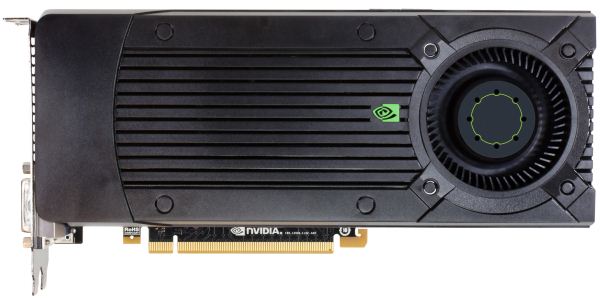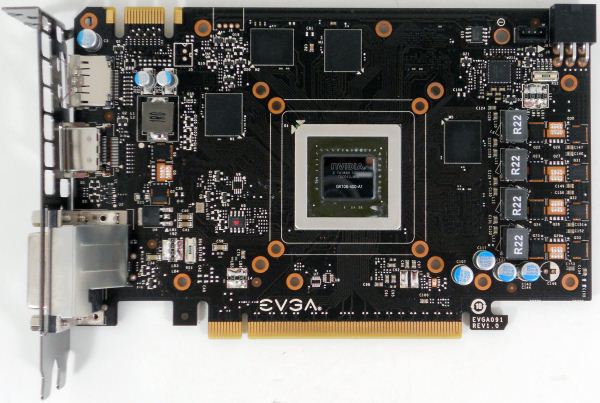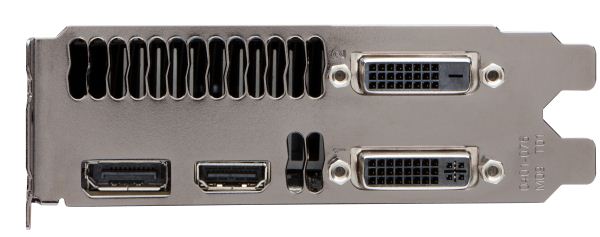The NVIDIA GeForce GTX 660 Review: GK106 Fills Out The Kepler Family
by Ryan Smith on September 13, 2012 9:00 AM ESTMeet The GeForce GTX 660
For virtual launches it’s often difficult for us to acquire reference clocked cards since NVIDIA doesn’t directly sample the press with reference cards, and today’s launch of the GeForce GTX 660 launch is one of those times. The problem stems from the fact that NVIDIA’s partners are hesitant to offer reference clocked cards to the press since they don’t want to lose to factory overclocked cards in benchmarks, which is an odd (but reasonable) concern.
For today’s launch we were able to get a reference clocked card, but in order to do so we had to agree not to show the card or name the partner who supplied the card. As it turns out this isn’t a big deal since the card we received is for all practical purposes identical to NVIDIA’s reference GTX 660, which NVIDIA has supplied pictures of. So let’s take a look at the “reference” GTX 660.
The reference GTX 660 is in many ways identical to the GTX 670, which comes as no great surprise given the similar size of their PCBs, which in turn allows NVIDIA to reuse the same cooler with little modification. Like the GTX 670, the reference GTX 660 is 9.5” long, with the PCB itself composing just 6.75” of that length while the blower and its housing composes the rest. The size of retail cards will vary between these two lengths as partners like EVGA will be implementing their own blowers similar to NVIDIA’s, while other partners like Zotac will be using open air coolers not much larger than the reference PCB itself.
Breaking open one of our factory overclocked GTX 660 (specifically, our EVGA 660 SC using the NV reference PCB), we can see that while the GTX 670 and GTX 660 are superficially similar on the outside, the PCB itself is quite different. The biggest change here is that while the 670 PCB made the unusual move of putting the VRM circuitry towards the front of the card, the GTX 660 PCB once more puts it on the far side. With the GTX 670 this was a design choice to get the GTX 670 PCB down to 6.75”, whereas with the GTX 660 it requires so little VRM circuitry in the first place that it’s no longer necessary to put that circuitry at the front of the card to find the necessary space.
Looking at the GK106 GPU itself, we can see that not only is the GPU smaller than GK104, but the entire GPU package itself has been reduced in size. Meanwhile, not that it has any functional difference, but GK106 is a bit more rectangular than GK104.
Moving on to the GTX 660’s RAM, we find something quite interesting. Up until now NVIDIA and their partners have regularly used Hynix 6GHz GDDR5 memory modules, with that specific RAM showing up on every GTX 680, GTX 670, and GTX 660 Ti we’ve tested. The GTX 660 meanwhile is the very first card we’ve seen that’s equipped with Samsung’s 6GHz GDDR5 memory modules, marking the first time we’ve seen non-Hynix memory on a GeForce GTX 600 card. Truth be told, though it has no technical implications we’ve seen so many Hynix equipped cards from both AMD and NVIDIA that it’s refreshing to see that there is in fact more than one GDDR5 supplier in the marketplace.
For the 2GB GTX 660, NVIDIA has outfit the card with 8 2Gb memory modules, 4 on the front and 4 on the rear. Oddly enough there aren’t any vacant RAM pads on the 2GB reference PCB, so it’s not entirely clear what partners are doing for their 3GB cards; presumably there’s a second reference PCB specifically built to house the 12 memory modules needed for 3GB cards.
Elsewhere we can find the GTX 660’s sole PCIe power socket on the rear of the card, responsible for supplying the other 75W the card needs. As for the front of the card, here we can find the card’s one SLI connector, which like previous generation mainstream video cards supports up to 2-way SLI.
Finally, looking at display connectivity we once more see the return of NVIDIA’s standard GTX 600 series display configuration. The reference GTX 660 is equipped with 1 DL-DVI-D port, 1 DL-DVI-I port, 1 full size HDMI 1.4 port, and 1 full size DisplayPort 1.2. Like GK104 and GK107, GK106 can drive up to 4 displays, meaning all 4 ports can be put into use simultaneously.














147 Comments
View All Comments
CeriseCogburn - Wednesday, September 19, 2012 - link
Hey Gilligan, stop ragging.Gastec - Thursday, November 15, 2012 - link
Nvidia cards are for rich people. ATI/AMD cards are for poor people. Just like rich people drive Mercedes and poor people drive american cars. Is that enough for you want more? I was poor and I had to buy a ATI card. Now I'm not poor anymore so I'm going to buy a Nvidia card in December. Quod erat demonstrandum. Now fuck off!Model192 - Friday, December 7, 2012 - link
I have a Corvette and I buy AMD. Guess I'm double retarded? Or does the Corvette not quite fit into your theory about being poor and buying AMD/ATI.nerrrd - Wednesday, March 13, 2013 - link
corvettes are american cars...stm1185 - Thursday, September 13, 2012 - link
Techpowerup includes more games where AMD has a slight edge, but does that edge make a difference in those games? I'd argue no because frame rate in a console port adventure game like Alan Wake is not a big deal.Also face it most of those 2012 games are mediocre. Who is spending 60 hours a week playing Sniper Elite or Max Payne? No one, but for SC2, BF3, Skyrim, they do, hell some guys have to by contract!
7870 is not a better card, it's about equal, or worse depending on what you play. For a competitive gamer, the GTX660 is the better card, because it's better for BF3, and it's better for SC2 (Amazingly so, best SC2 card!).
RussianSensation - Thursday, September 13, 2012 - link
Data does not back up your claimsBF3 - factory overclocked 660 trades blows with a factory overclocked 7870
http://www.hardocp.com/article/2012/09/13/asus_gef...
BF3 - barely any difference (but comparing a reference 660 it doesn't win either)
http://www.techpowerup.com/reviews/ASUS/GeForce_GT...
Skyrim - 7870 wins
http://www.hardocp.com/article/2012/09/13/asus_gef...
Skyrim - 7870 wins
http://www.techpowerup.com/reviews/ASUS/GeForce_GT...
Add mods to Skyrim and 7870 wins by 20-40%
http://www.computerbase.de/artikel/grafikkarten/20...
Also, you are discounting performance in 12-15 games and just focusing on the games you think are most important. That's your opinion. Starcraft 2 for example is playable on a GTX560/HD6870 without any problems. Plus in a strategy game you only need 30-45 fps for it to feel smooth and modern cards get 70-100 fps! So really your point about SC2 is hardly relevant.
The reason we look at more games is because not everyone spends 200 hours a month playing BF3 only.
Overall, 660 is not any better (actually a slower card unless you consider factory overclocked versions)
http://www.computerbase.de/artikel/grafikkarten/20...
stm1185 - Thursday, September 13, 2012 - link
So Anandtech is lying then? Those numbers I see right above this post are false?Margalus - Thursday, September 13, 2012 - link
sorry, but you lost all credibility by linking hardocp. That is the worst hardware site on the internet. They gave up all premises of being unbiased and fair years ago.ninjaquick - Thursday, September 13, 2012 - link
? They compare OC parts with OC parts, rather than average out the OC parts results and place them against stock parts.Different systems have different results, Anandtech didn't lie, AFAICT. nobody has fudged results (esp. not w1zzard)
formulav8 - Thursday, September 13, 2012 - link
No cred lost. Your opinion only. Hardocp simply uses different methods of comparison. Some like it, some don't.